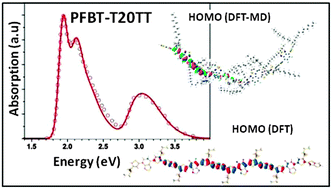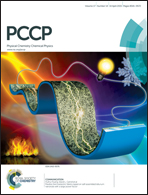Elucidating the enhancement in optical properties of low band gap polymers by tuning the structure of alkyl side chains
Abstract
We carry out a computational study of optical properties of two novel 5,6-difluorobenzo[c][1,2,5]-thiadiazole-based polymers, PFBT-T20TT and PFBT-T12TT, to elucidate the surprisingly superior performance of polymer solar cells based on the former, when it differs from the latter only in the alkyl side chains. Density Functional Theory (DFT) based geometry optimization at the B3LYP/6-31G(d) level reveals differences in internal coordinates, which are important in tuning the electronic and optical properties. We further calculate the electronic structure at room temperature by employing molecular dynamics (MD) simulations in combination with DFT techniques. The energies of the highest occupied molecular orbital (HOMO) are found to be in reasonable agreement with the available experimental data and the HOMO-lowest unoccupied MO energy gap is found to be similar for both the molecules. The electronic density of the HOMO in PFBT-T20TT is, however, found to be significantly more delocalized along the backbone, which is proposed to be conducive for the formation of charge separated states leading to an improved device performance. Furthermore, via fitting the absorption spectra calculated with the multi-mode Brownian Oscillator model, we have also extracted a weaker exciton–phonon coupling parameter in PFBT-T20TT, consistent with the trends revealed via the DFT-MD results.


 Please wait while we load your content...
Please wait while we load your content...